MARIANI’S
Virtual
Gourmet
February
24, 2019
NEWSLETTER
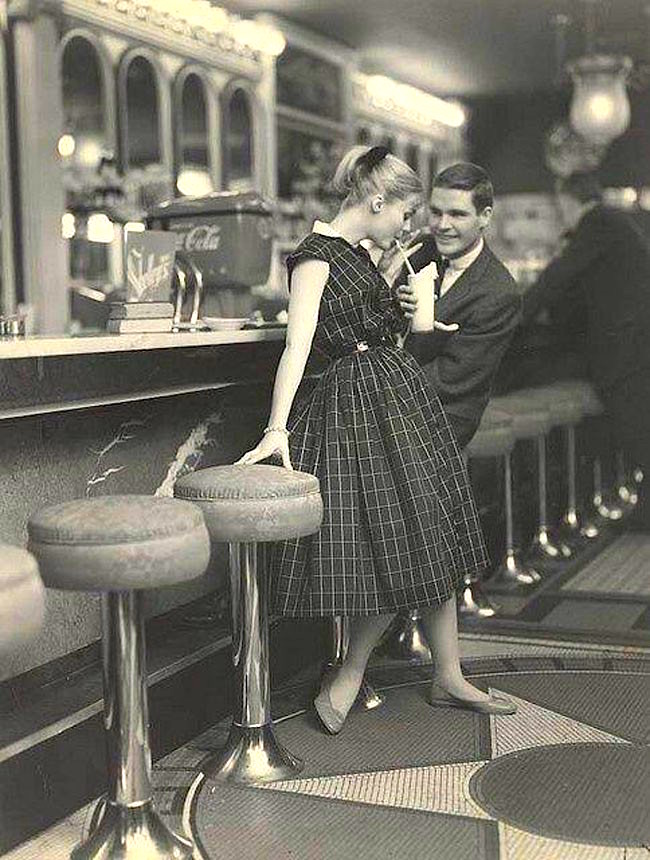
Schrafft's
Soda Fountain, 1954
IN THIS ISSUE
EATING AROUND MADRID
Part Two
By John Mariani
NEW YORK CORNER
WOLFGANG'S STEAKHOUSE
By John Mariani
NOTES FROM THE WINE CELLAR
A RUM COMES FROM BROOKLYN
By John Mariani
❖❖❖
EATING AROUND MADRID
Part Two
By John Mariani
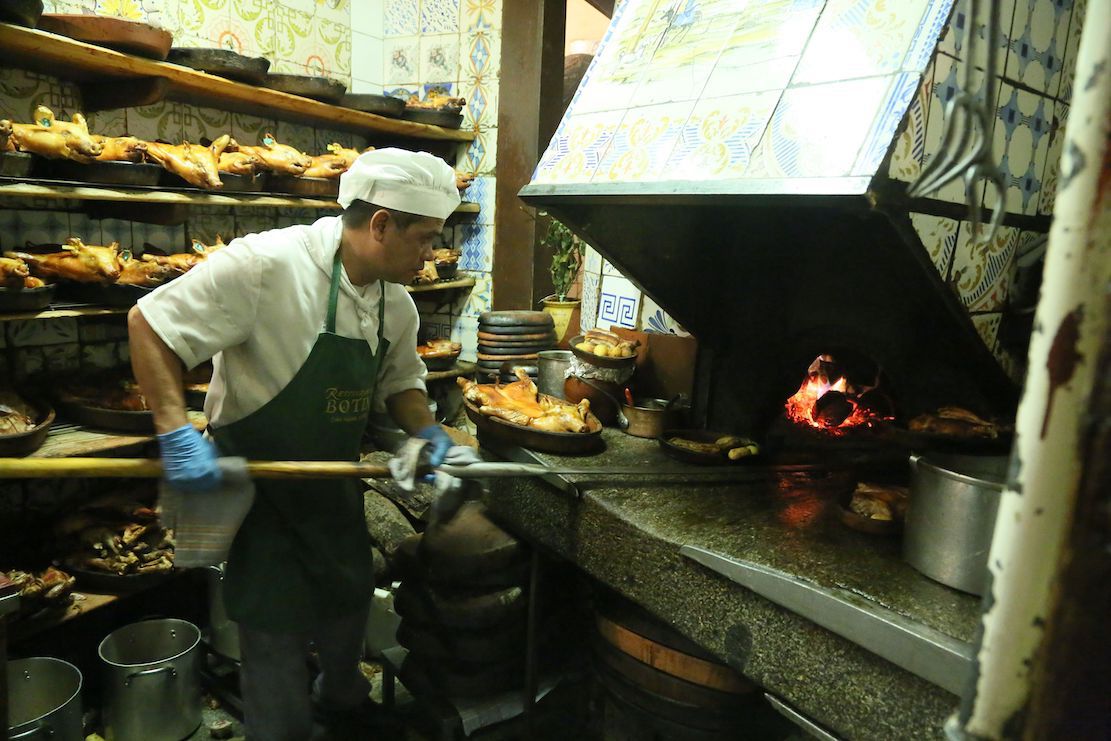
Roasting suckling pigs at Botin. Photo: Gerry Dawes
The
new, innovative restaurants of Madrid that
I wrote about last week are wonderful
enticements to dine out in this splendid
city. Still, the traditional tabernas, tapas
bars and restaurantes that you find on
every corner and tucked away in
markets are where you’ll still find the culinary
soul of the Madrileños. Here
are three where it is always vibrant and true to
the spirit of Iberia.
BOTIN
Calle
de Cuchilleros 17
91-366-42-17
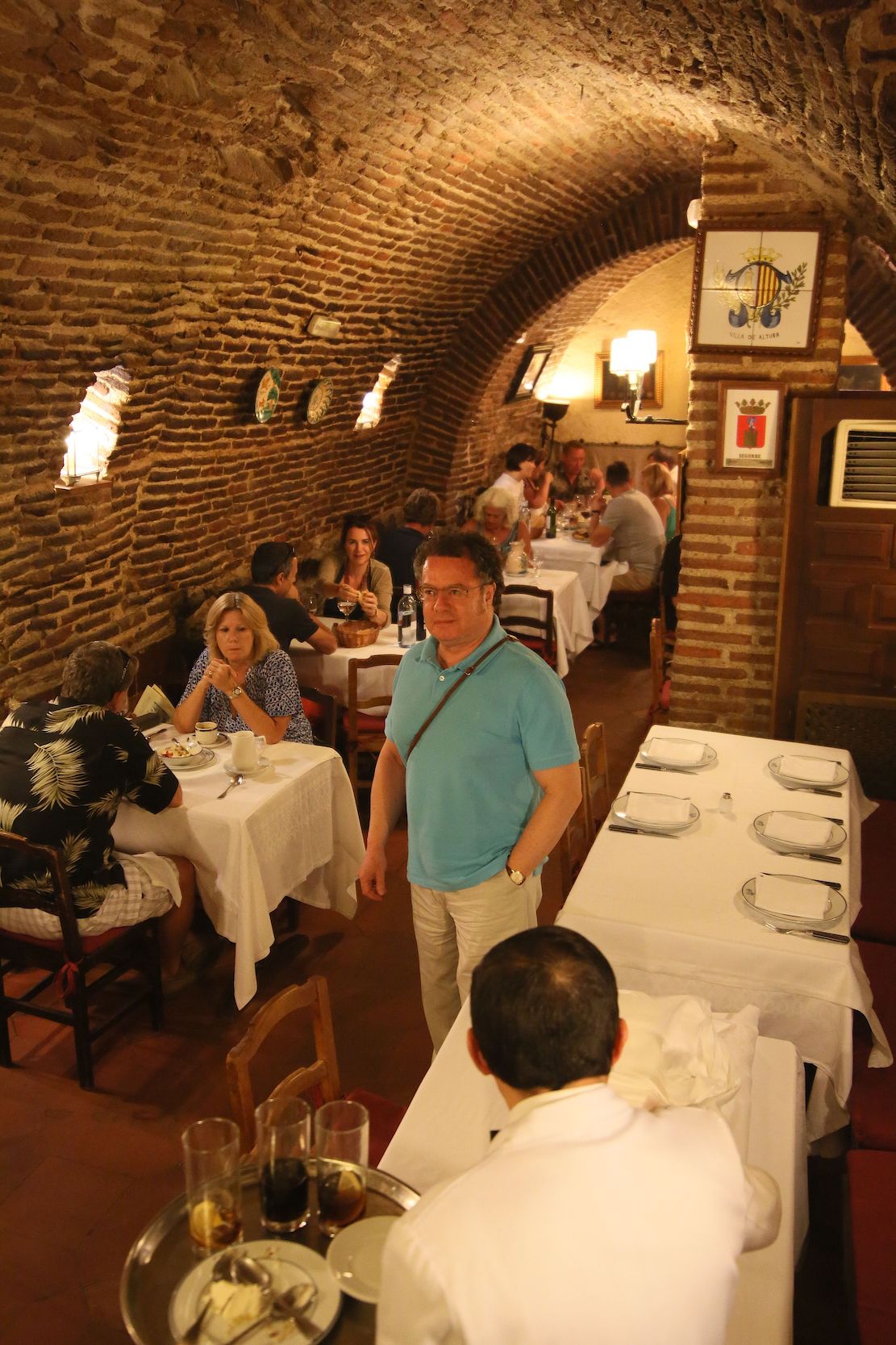 No
visitor can avoid at least consideration of
dining at Botin, founded in 1725 and claiming to
be the oldest restaurant in
the world. The claim is arguable, but the founding
date is indisputable, its
history detailed in a brochure at the restaurante.
This distinction, added to Ernest Hemingway’s
claim to Botin being the best
restaurant in the world and including it in his
novel The Sun Also Rises, makes a visit
almost a requisite pilgrimage.
No
visitor can avoid at least consideration of
dining at Botin, founded in 1725 and claiming to
be the oldest restaurant in
the world. The claim is arguable, but the founding
date is indisputable, its
history detailed in a brochure at the restaurante.
This distinction, added to Ernest Hemingway’s
claim to Botin being the best
restaurant in the world and including it in his
novel The Sun Also Rises, makes a visit
almost a requisite pilgrimage.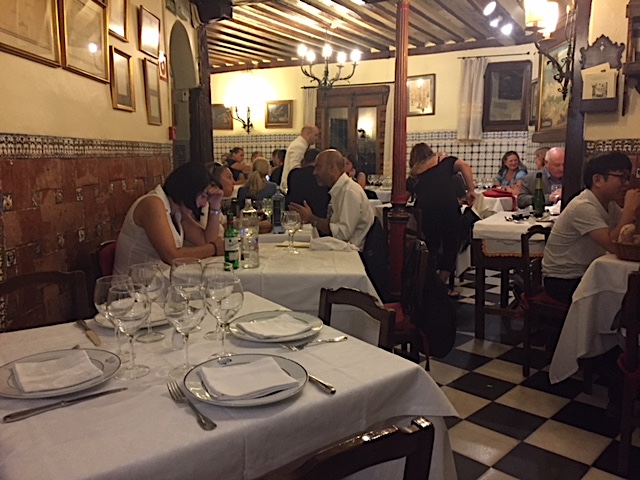
You will, however, be told by
many Madrileños
that, while Botin’s food is as good as ever, the
day-and-night onslaught of
tourists and the difficulty of getting a
reservation at any hour makes it a
trial to get in.
Debate still rages as to which
room has the best tables—the
brick walled downstairs room or the sun-lit, blue
tiled upstairs (where the
scene in The
Sun Also Rises takes
place). Once
seated, you will be
treated to service by fleet-footed veteran waiters
who go through the motions
of serving the thousandth suckling pig and roast
lamb of the week.
Photo: Gerry Dawes
That
said, a visit to Botin is to enter a
significant marker of Spanish cultural and
culinary history, its walls hung
with reminders of all the great ones who have
passed through its doors. The
menu, sanctified over decades, offers a dozen
appetizers, like roasted red
peppers with codfish (€14.30), 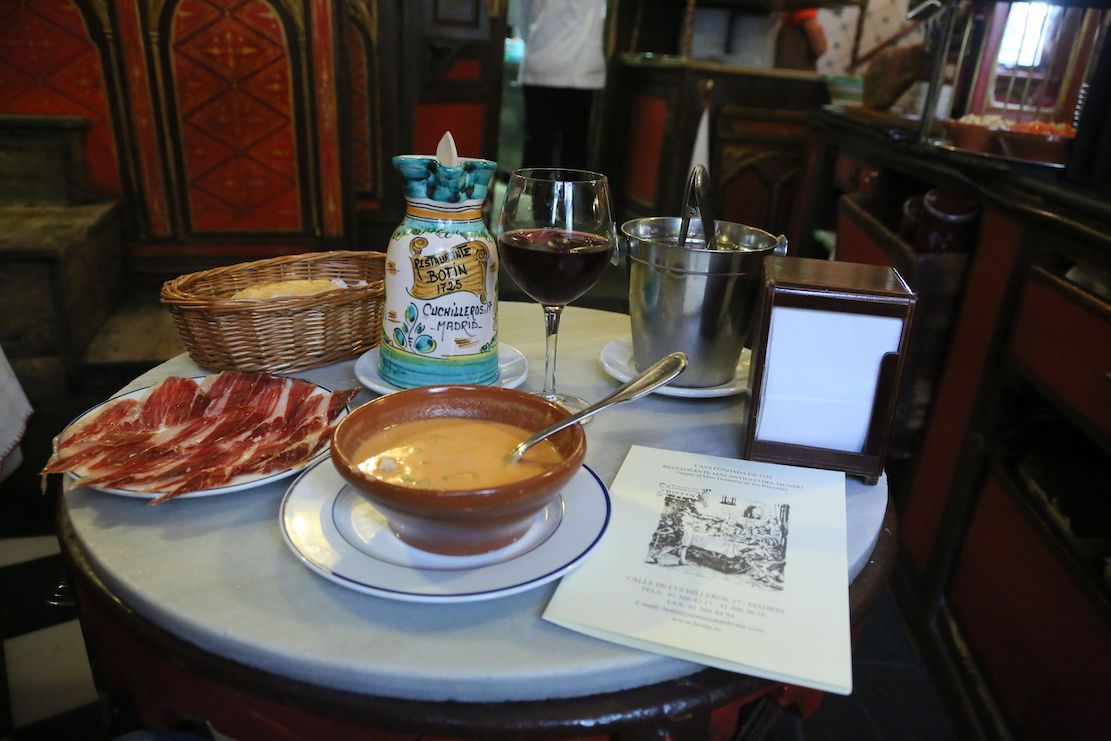 cured Iberian ham
(€24.50), croquettes (€11) and
Burgos black sausage (€11), along with four soups
that include an unorthodox
but very good, orange-colored Andalusian-style
gazpacho with chopped cucumbers,
tomatoes, peppers and croutons (€9).
cured Iberian ham
(€24.50), croquettes (€11) and
Burgos black sausage (€11), along with four soups
that include an unorthodox
but very good, orange-colored Andalusian-style
gazpacho with chopped cucumbers,
tomatoes, peppers and croutons (€9).
There’s a fairly extensive, and
expensive, wine
list, but no vintages are listed for most bottles;
they also offer house wines
(€15.70 and €18.90) and Sangria by the pitcher
(€13.70). My
requested daiquiri (Hemingway’s
favorite cocktail) was much inferior to others I
enjoyed around Madrid.
Photo: Gerry Dawes
We
began with bubbling hot garlic shrimp
(€23.90), which could have used more garlic and
seasoning. Then came the two
famous dishes. The roast suckling pig (€25) was
excellent, a crisp crust sliced
to 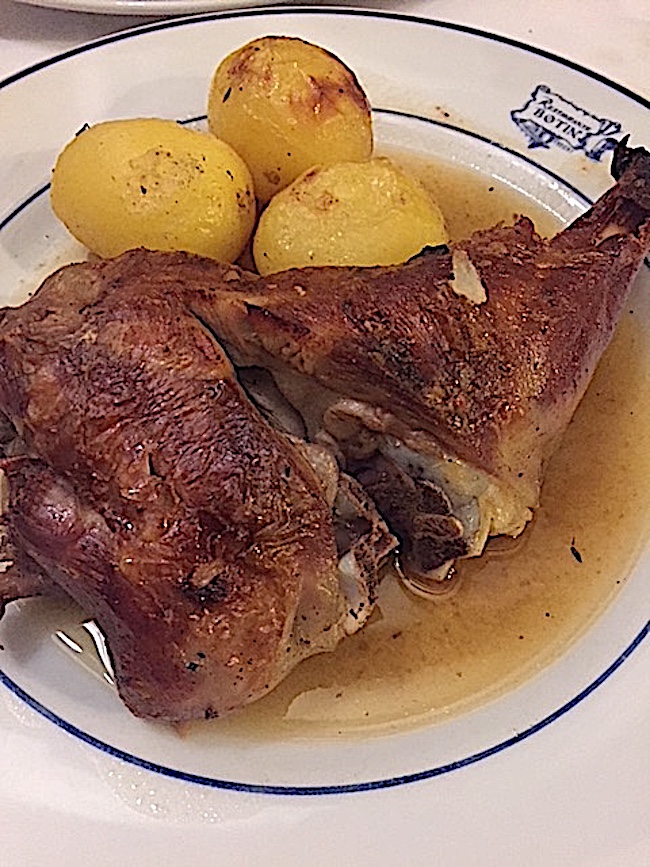 ooze
succulence within the creamy, fatted meat. (You
can watch a video of
its preparation on the restaurant’s website.) The
roast baby lamb (€25) was
just as delicious, cooked to the point where the
flavors of suffused garlic and
herbs emerged.
Boiled
potatoes were the accompaniment.
ooze
succulence within the creamy, fatted meat. (You
can watch a video of
its preparation on the restaurant’s website.) The
roast baby lamb (€25) was
just as delicious, cooked to the point where the
flavors of suffused garlic and
herbs emerged.
Boiled
potatoes were the accompaniment.
Mediocre desserts like cheesecake with
white chocolate (€6.70) and tarta Botin,
a cream layer cake (€6.70),
are hardly necessary after such heartiness.
There is a house menu in spring
and summer
(€45.90) for that fine gazpacho, the pig and ice
cream, with a half-bottle of
wine and mineral water.
You can eat as well at
similar restaurantes
in Madrid, but Botin has a
cachet well worth savoring for its history and its
consistency, and it is also
located in an old neighborhood buzzing with
nightlife from every doorway and
outside patio. I wouldn’t fret about what room you
sit in. Hemingway may have
overstated the case for Botin a bit, but it’s not
a place I would want to miss
on a first trip to Madrid.
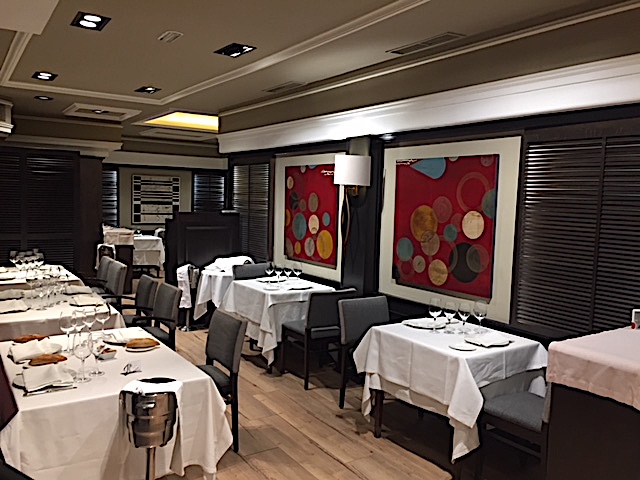 MARISQUERIA
RAFA
MARISQUERIA
RAFA
Calle
de Narváez 68
91-573-1087
Madrid’s
restaurants like Botin may be famous
for their pig and lamb, but excellent seafood is
abundant in the city, which
has a huge seafood market named Mercamadrid—second
only to Tokyo’s in size—just
on the outskirts, that supplies the best,
well-established restaurants, like
Rafa, with superb product. Rafa was opened in 1958
by brothers Rafael and
Rodrigo Andrés, first as a small bar, and today it
is a large establishment
managed 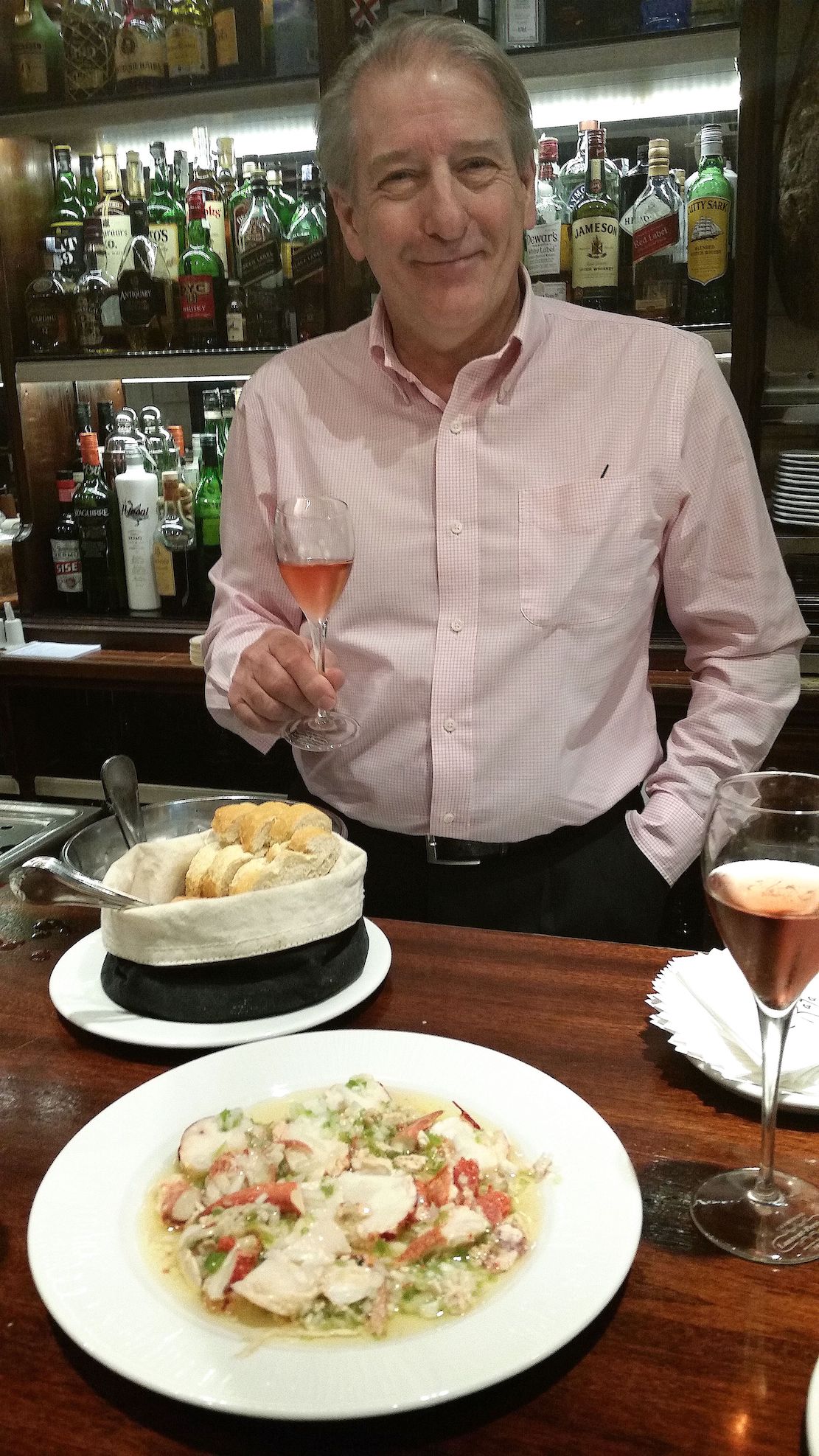 by their
sons Rafael (right)
and Miguel as one of the city’s most respected
traditional dining spots. It’s also nice to know
that it’s one of the few restuarantes
in town open on Sunday nights.
by their
sons Rafael (right)
and Miguel as one of the city’s most respected
traditional dining spots. It’s also nice to know
that it’s one of the few restuarantes
in town open on Sunday nights.
Photo: Gerry Dawes
Many Madrileños come around 8:30 p.m., when the
restaurant opens, to stand at the handsome tapas
bar and sip cava
sparkling wine. My wife and I, on a
perfect autumn evening, sat outside under a white
umbrella at a table just feet
from the bustling avenue, but it was not too loud
for a good conversation with
Rafael, who made suggestions from a wide menu with
a superb wine list to back
it up.
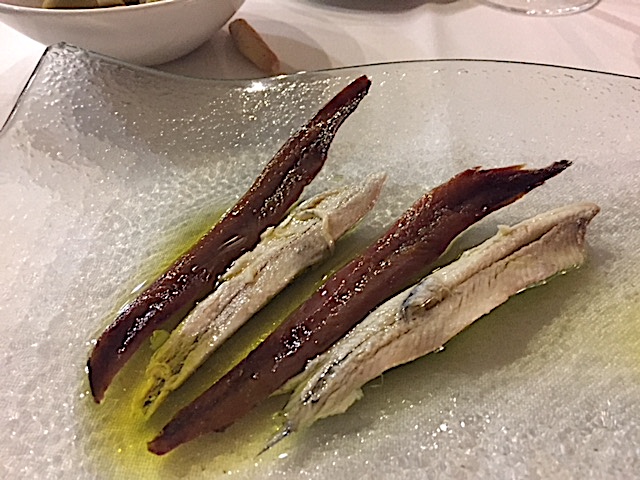 We began
with incomparable, sweet and nutty
Joselito ham (€18), expertly cut in thin squares,
and nibbled on two kinds of
fresh anchovies in olive oil (left).
Fried Andalusian calamari with tomato (€12)
were crunchy and sweet.
We began
with incomparable, sweet and nutty
Joselito ham (€18), expertly cut in thin squares,
and nibbled on two kinds of
fresh anchovies in olive oil (left).
Fried Andalusian calamari with tomato (€12)
were crunchy and sweet.
For a main course there
were fine filets of
baked sole (€24), carefully cooked for texture and
juiciness. A
grilled bogavante (lobster) was very
expensive at €75, especially since
European lobsters don’t have the amount of meat or
the rich flavor of American
lobsters. Bizcocho
borracho (€7),
“drunken biscuit,” soaked in rum, was a fine and
simple ending to the meal.
CERVECERIA
SANTA ANA
Plaza de Santa Ana, 10
914 29 36 35
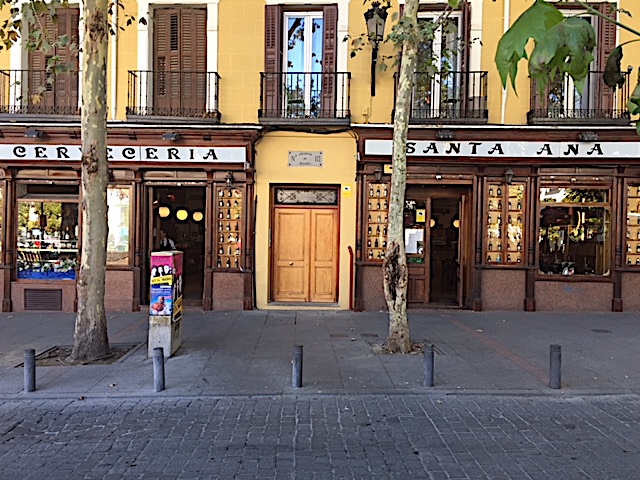 There
are so many places in Madrid that claim a
Hemingway connection that there used to be a bar
with a defiant sign reading,
in English, “HEMINGWAY DID NOT EAT HERE.” One
place he did frequent, largely to
hang out with Madrid’s matadors, was Cerveceria
Alemana on Plaza Santa Ana,
which began as a brewery in 1904. Today it’s a big
tourist stop and the menu is
limited to tapas like fried seafood and cured
meats. The Plaza itself, until
1810, was home to a convent of
Carmelite nuns.
There
are so many places in Madrid that claim a
Hemingway connection that there used to be a bar
with a defiant sign reading,
in English, “HEMINGWAY DID NOT EAT HERE.” One
place he did frequent, largely to
hang out with Madrid’s matadors, was Cerveceria
Alemana on Plaza Santa Ana,
which began as a brewery in 1904. Today it’s a big
tourist stop and the menu is
limited to tapas like fried seafood and cured
meats. The Plaza itself, until
1810, was home to a convent of
Carmelite nuns.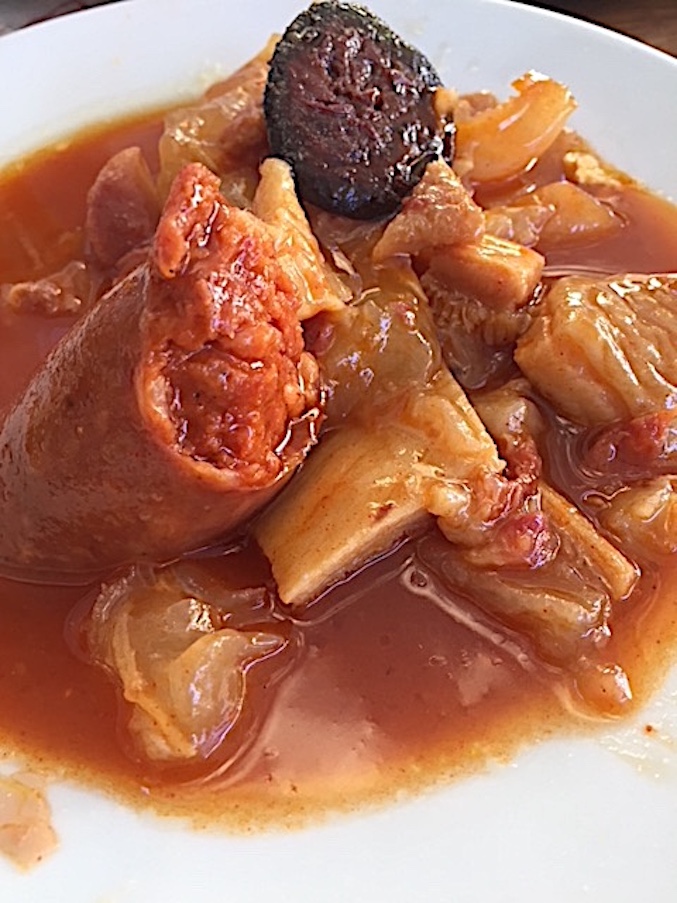
My wife and I headed dutifully
to Alemana for a return
visit, but it was Tuesday and it was closed.
Fortunately, two doors away,
Cerveceria Santa Ana was open, and the tables on
the Plaza were too. Inside,
the décor looks like a thousand other bars in
Madrid, though the place only
debuted in 1985.
There are plenty of tortas, bocadillos and the usual
tapas. The menu is longer than
Alemana’s, with a lot more gutsy items like tripe
stew (€10), which is as
hearty a dish as I’ve ever had in Spain—not to
everyone’s taste but certainly
it is to mine (right). We
began with the
ubiquitous plate of
pa amb
tomàquet—slices
of
toasted bread spread with the juice and filet of
tomatoes and a mess of
glistening sweet green peppers cooked in olive oil
(€7.50)— along with ice cold
Cruzcampo pilsner. We also had baked ham that came
in thick slices, topped with
boiled potatoes (€9), and for dessert shared a pastelito of torrone meringue and
hazelnuts (€3).
Cerverceria
Santa Ana stays open till 1:30
a.m.—an hour later that Cerverceria Alemana—and
the plaza is a wonderful place
to watch the locals come and go and to end a night
in Madrid.
❖❖❖
By John Mariani
4
Park Avenue
212-889-3369
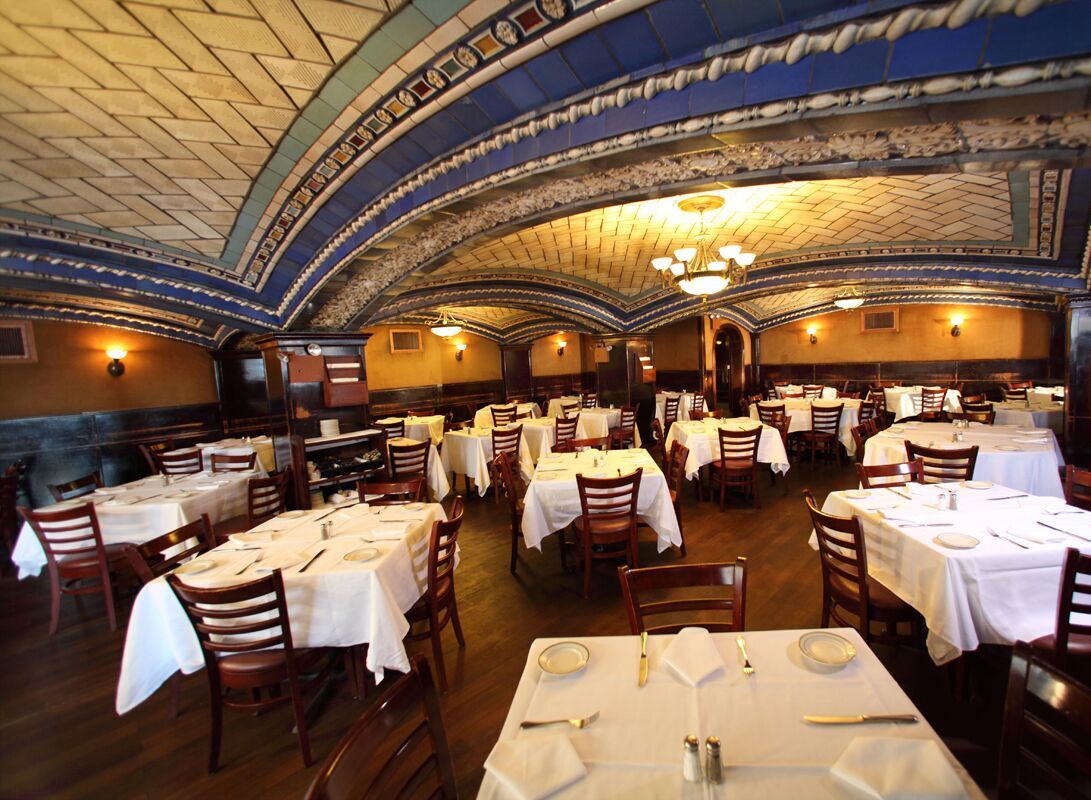
For some free-spending
carnivores, Peter Luger
in Brooklyn is the totemic steakhouse
in America, a 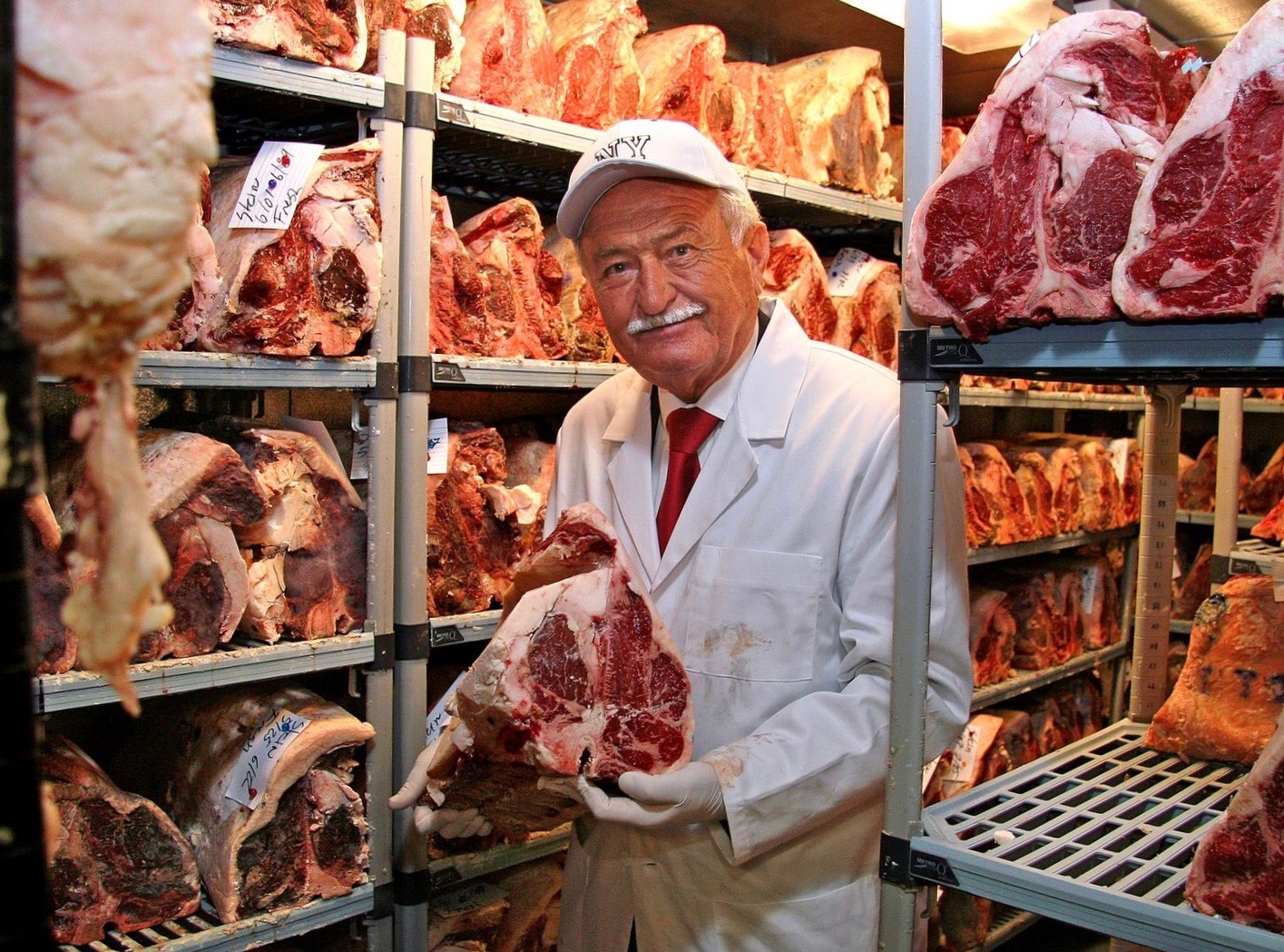 claim
I would rebut by saying that, although its
famous sliced
porterhouse is a nonpareil piece of beef,
the décor, the side dishes, the
restricted menu options, dreary décor,
rudimentary service, cash only policy and
the month’s long
wait for a table keep it far from the top
of my list of America’s best
steakhouses.
claim
I would rebut by saying that, although its
famous sliced
porterhouse is a nonpareil piece of beef,
the décor, the side dishes, the
restricted menu options, dreary décor,
rudimentary service, cash only policy and
the month’s long
wait for a table keep it far from the top
of my list of America’s best
steakhouses.
Still, Luger’s stylistic
influence has been
significant in New York, and it was a smart
move when Luger’s long-time
headwaiter, Wolfgang Zwiener, opened his
namesake steakhouse at 4 Park Avenue
fifteen years ago. The menu, much enlarged
from Luger’s, mimicked the service
of sliced porterhouse served on a tilted,
sizzling platter, but in its décor
achieved a grandeur that Luger’s never dreamed
of. The space was once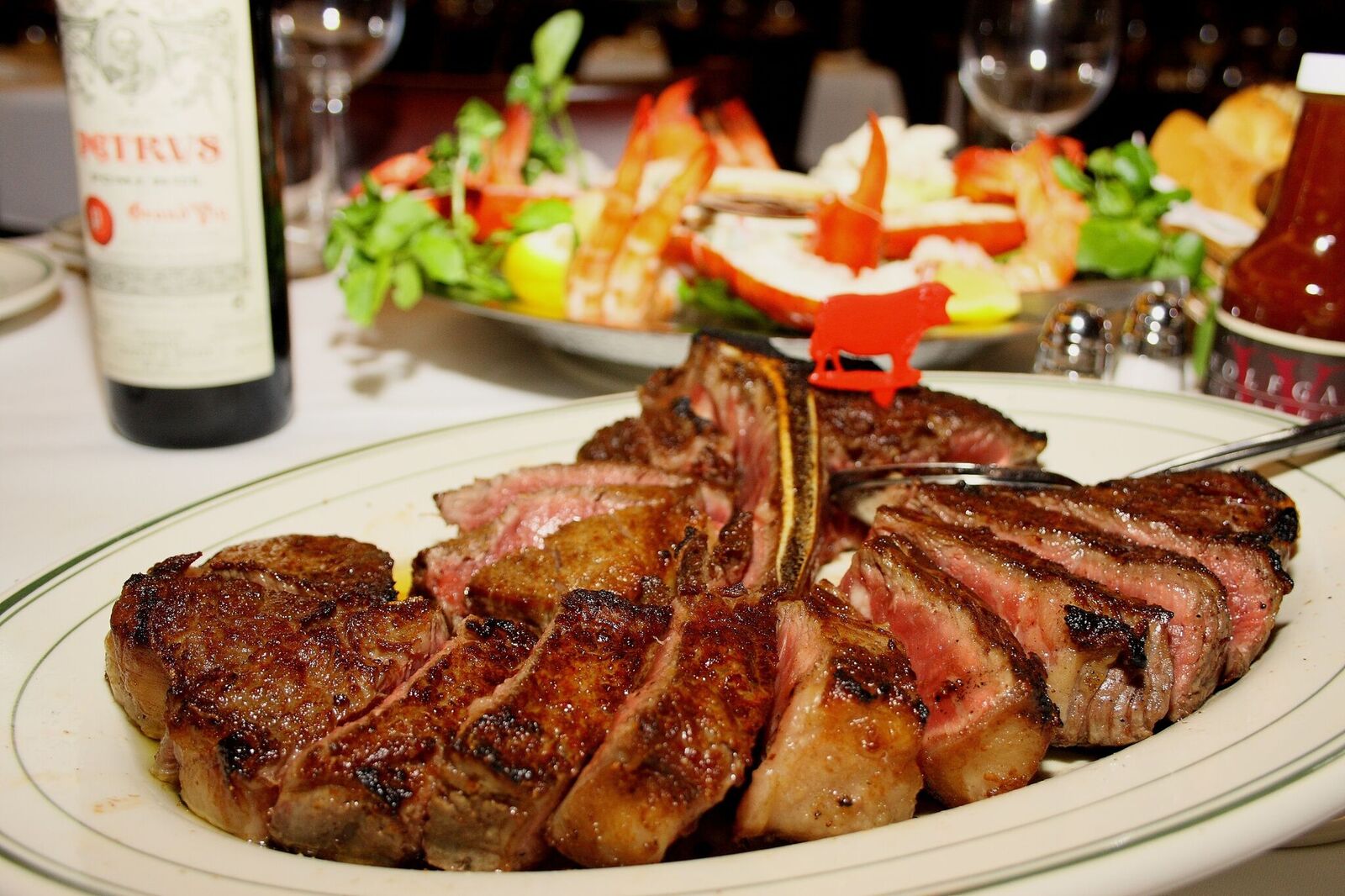 the
old
Vanderbilt Hotel, whose lower vault was tiled
in Della Robbia-style tiles by R.
Guastavino, who also did the magnificent tile
work at Ellis Island and the
Grand Central Oyster Bar.
the
old
Vanderbilt Hotel, whose lower vault was tiled
in Della Robbia-style tiles by R.
Guastavino, who also did the magnificent tile
work at Ellis Island and the
Grand Central Oyster Bar.
The ceiling is uniquely
beautiful but low, so
that when Wolfgang’s is full—which is pretty
much every night of the week—with
an overwhelming number of large men who prefer
bellowing to conversation, the
noise level can be fierce. Fortunately, on my
last visit, I learned of a small
back room, also beautifully tiled, where you
can spend an evening enjoying your
guests’ company.
The
veteran staff has learned all the nuances
of coping with the rush of men and Martinis
that fuel the atmosphere. You’ll be
well greeted and seated, and, with a large
complement of émigré Eastern European
waiters, each with his own buoyant sense of
humor, getting your drinks, wine
and food has 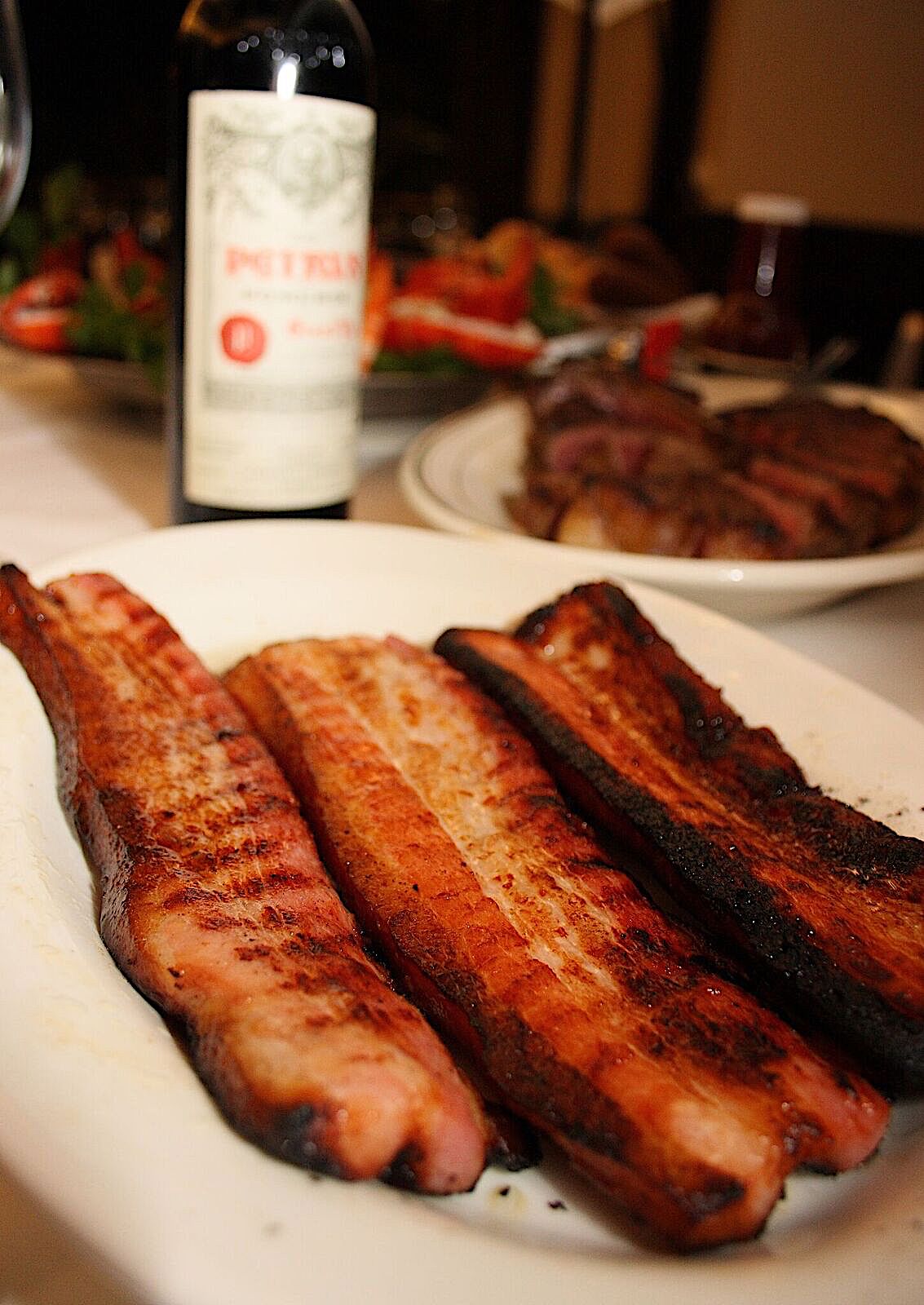 become a matter of
canny timing.
become a matter of
canny timing.
There are now 22 units of
Wolfgang’s around the
world, all claiming to serve the finest USDA
Prime beef, as do all their direct
competitors.
I haven’t the
first-hand experience to guarantee that the
quality elsewhere is the same as at
this Park Avenue original, but the original
serves dry-aged beef as good as any
in New York.
All the usual cuts are in
evidence, including
New York strip, rib-eye, filet mignon and the
porterhouse for two or more, all
cooked on a 1600º grill, which renders the
outside as charred as you wish it to
be. The tradition of putting those gorgeous
steaks on a red-hot platter is not,
to my mind, a boon, for it continues to cook
the meat.
I therefore like to get it off
those plates ASAP.
Start off simply with jumbo
crabmeat ($24.95)
or shrimp ($24.95) or the crab cake packed to
the right texture without much
filler ($22.95). The lobster bisque ($13.95)
is richly flavored  with lobster,
if a little thin, and the chopped salad
($15.95) is big and abundant with
greens and vegetables, easy enough for two to
share. So is the massive slab of
fat-rich bacon (left), a steal at $8.95.
with lobster,
if a little thin, and the chopped salad
($15.95) is big and abundant with
greens and vegetables, easy enough for two to
share. So is the massive slab of
fat-rich bacon (left), a steal at $8.95.
Not all New York
steakhouses serve lobsters
these days—Luger doesn’t —but Wolfgang’s
always has the big ones (market
price), steamed or grilled to perfection and
expertly cracked. I like to take the meat
out by myself; otherwise it loses
heat fast if done in the kitchen or at the
table.
Our table of four had a
porterhouse for two
($53.95 per person) and took much of it home,
a very juicy, huge rack of lamb
chops ($49.95), and a five-pound lobster with
clarified butter.
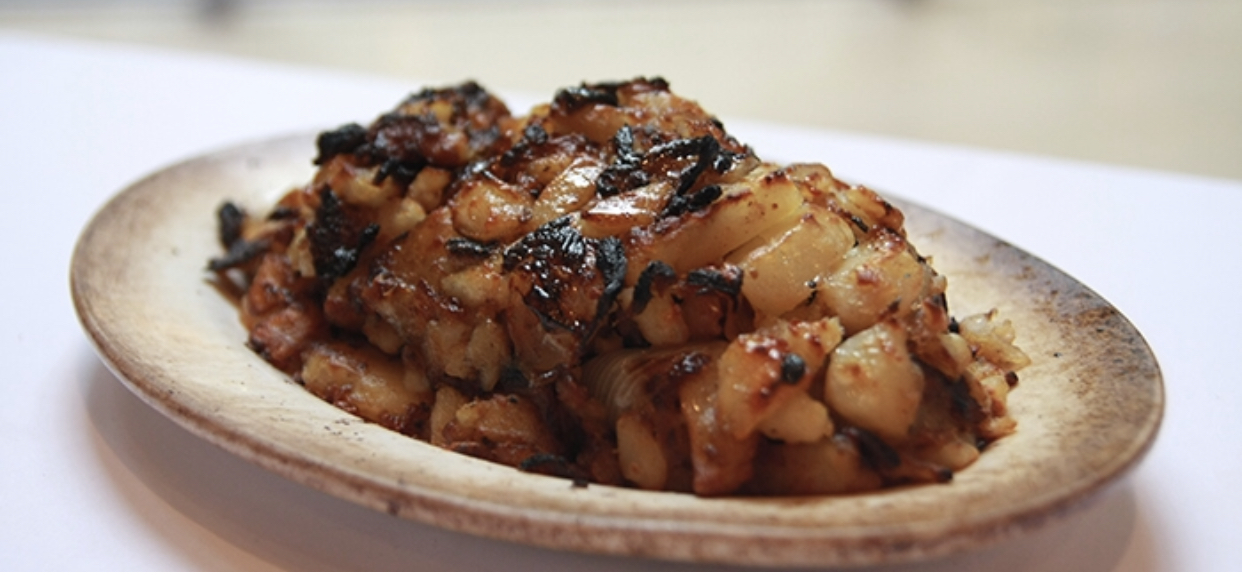 The
side dish of buttery, onion-inflected
German potatoes ($12.95) was very generous (left),
and the creamed spinach ($11.95)
had a that nice hint of nutmeg in a
well-balanced mélange of spinach, cream and
butter.
The
side dish of buttery, onion-inflected
German potatoes ($12.95) was very generous (left),
and the creamed spinach ($11.95)
had a that nice hint of nutmeg in a
well-balanced mélange of spinach, cream and
butter.
Desserts are what you’d
expect and the
cheesecake ($11.95) is the best of
them.
Wolfgang’s wine list is
long and deep, and
top-heavy with big Cabernets at hefty prices,
with very little under $100. The commodious
bar is where
you’ll find an impressive collection of
international whiskies and other
spirits.
I don’t think of Wolfgang’s
as a competitor to
Luger, because to that Brooklyn institution’s
basics Wolfgang’s has added
beauty of décor, excellent, amiable service,
and an expansive menu with
something for everyone. That, and the fact
that you can pretty easily get a
reservation, makes it a far more appealing
option for a whole lot of people who don't
happen to live in Williamsburg and carry a lot
of cash around.
Wolfgang’s Steakhouse is open seven days a week for lunch and dinner.
❖❖❖
FROM BROOKLYN
By John Mariani
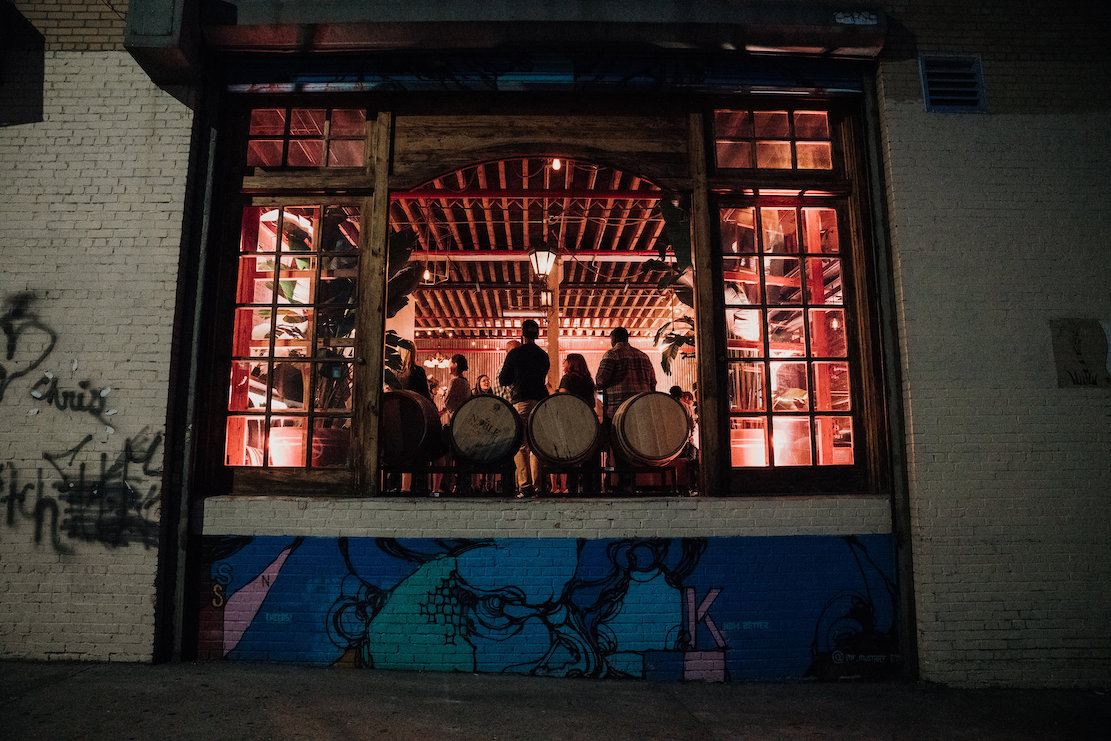
To paraphrase Thomas
Wolfe’s opening of Look
Homeward, Angel, it is a strange
destiny that leads a young woman to start making
rum in Bushwick, Brooklyn, and
naming it after a Prohibition rum runner named
Owen “Owney” Madden.
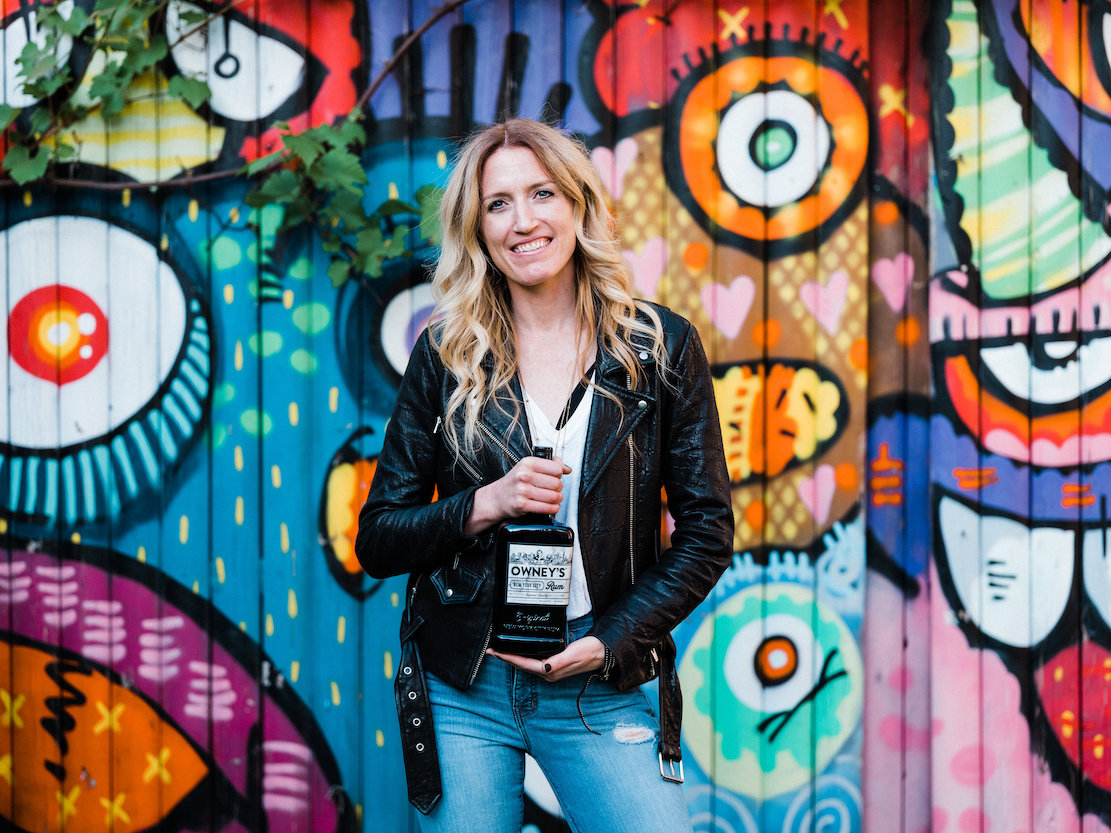 But when
you learn that Bridget Firtle (left), who
looks more than a little like a young Sheryl Crow,
was raised in Rockaway
Beach, Queens, (the next borough over) in a house
that had a speakeasy in its
basement, it starts to make more sense. Her
parents were small business owners,
and that kind of personalized entrepreneurship
stayed with her, causing her to
leave a job on Wall Street in 2012 to found The
Noble Experiment, the first rum
distillery in Brooklyn in nearly a century. The
idea was met with a good deal
of skepticism.
But when
you learn that Bridget Firtle (left), who
looks more than a little like a young Sheryl Crow,
was raised in Rockaway
Beach, Queens, (the next borough over) in a house
that had a speakeasy in its
basement, it starts to make more sense. Her
parents were small business owners,
and that kind of personalized entrepreneurship
stayed with her, causing her to
leave a job on Wall Street in 2012 to found The
Noble Experiment, the first rum
distillery in Brooklyn in nearly a century. The
idea was met with a good deal
of skepticism.
“Raising money was very hard,”
Firtle, 34, told
me over dinner in Manhattan. “Having worked on
Wall Street and watched
tremendous amounts of money fly around, I thought
it would be relatively easy
to find the amount I was looking for. It was
not. It took months of
networking and tons of energy pitching to close
the financing. And, as
most entrepreneurs would attest, the first round
was not enough.”
Still,
given her own investment experience on
Wall Street, she developed a solid business plan,
a pro forma financial
statement and accompanying model, and an
aesthetically pleasing pitch
deck.
“I could predict the glaring
questions that
would be asked, so I was then able to prepare
responses,” she said.
“Ultimately, the people who initially invested in
the distillery were people
who believed in the market opportunity, but more
so in my ability to execute
the vision. They were big risk takers who
had either worked with me or
studied with me. At the seed stage you really are
investing in people.”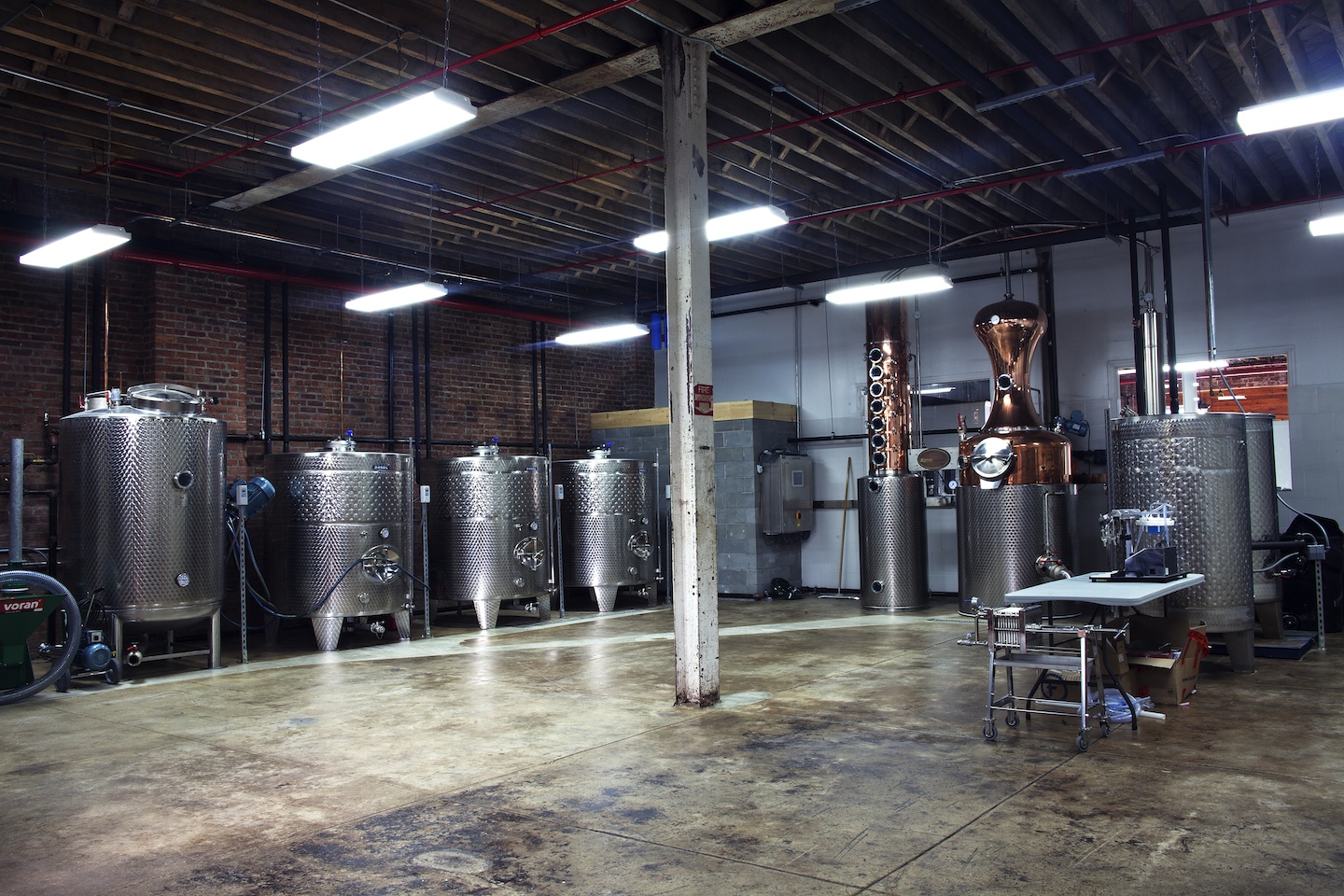
She did indeed go through a
myriad of
experiments before settling on a final recipe that
is unique in at least three
other ways, besides being made in Brooklyn.
“I noticed a lack of
high-quality white rums in
the market, so I set out to create an expression
different from everything else
in that category—a complex and flavorful un-aged
rum without additives, sugar or colorings. Then I
made sure I obtained the best
ingredients to use for fermentation and
distillation. We use an all-natural,
non-GMO domestic sugar cane molasses from farmers
in Florida and Louisiana.
“Second, we use our own
proprietary yeast, and
third, we use New York City filtered tap water,
which is chemically perfect and
balanced, not too soft and not too hard with
minerals.”
Contrary to most large-scale
production that
seeks to maximize speed by using esthers from oak
barrels for flavor and aiming
for a high alcohol proof, Owney’s Rum instead
undergoes a long and cold fermentation process that
may sacrifice yields for
flavor. “We flip typical commercial rum
fermentation style on its head in
hopes of forcing a process called esterification
in this step, as opposed to in
the barrel,” she said, referring to the chemical
process by which an alcohol
molecule binds with an organic acid and creates
an ester, or flavor, molecule.
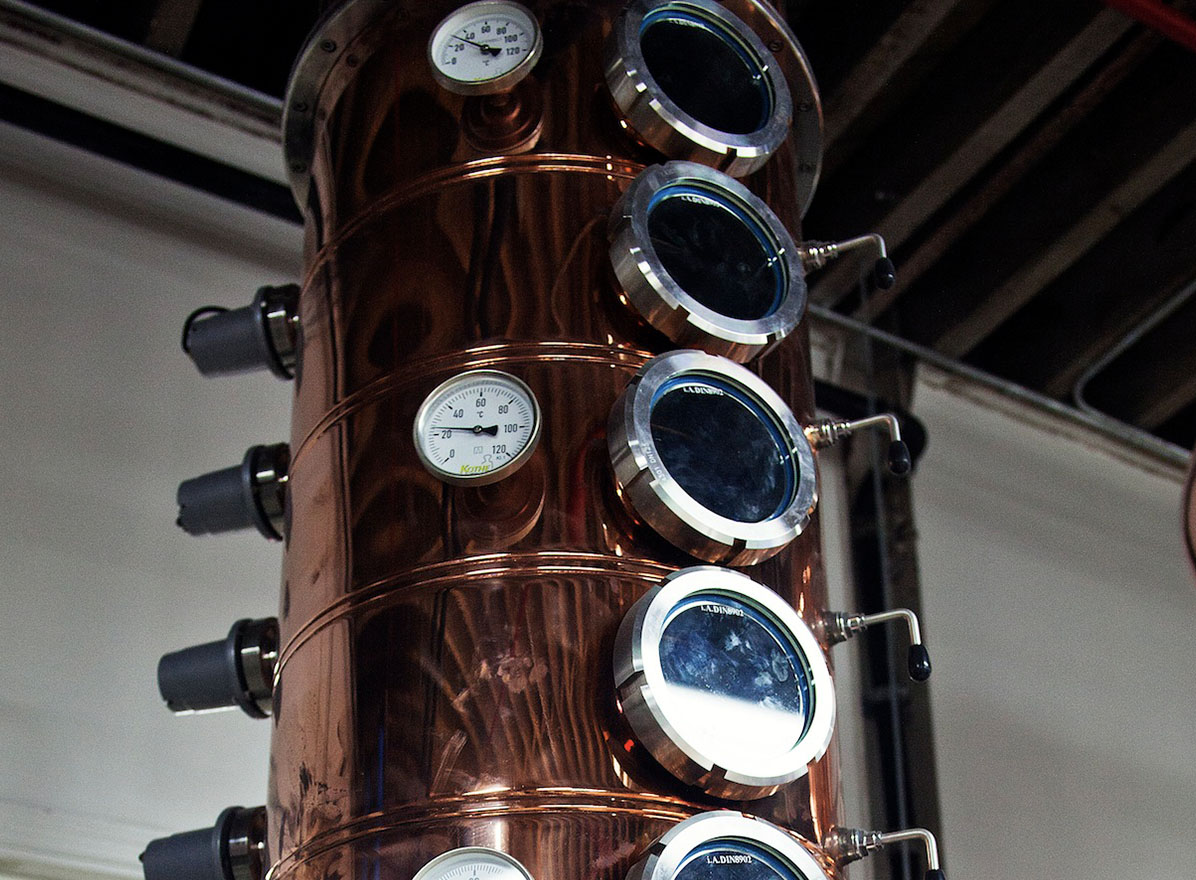 After
finding the recipe she
favored, Firtle and friends took over an old
warehouse on Meadow Street, used a
four-spout bottler to make the rum, stuck the
labels on by hand, then began
hustling the rum from the trunk of her car.
After
finding the recipe she
favored, Firtle and friends took over an old
warehouse on Meadow Street, used a
four-spout bottler to make the rum, stuck the
labels on by hand, then began
hustling the rum from the trunk of her car.
Owney’s
Rum ($28) is a blend
of Firtle’s original Distiller’s Reserve New York
white rum with a two-year-old
rum from the sugar cane farms of the Dominican
Republic, which enriches the
flavor, making this the rare white rum that has
any real complexity. The
process actually imitates what Prohibition era rum
runners used to do by
bringing Caribbean rum to New York to be blended
with locally distilled white
rum. (France’s Maison Ferrand’s Barbadian
Plantation Rum is actually finished
in Cognac and Calvados barrels in France.)
Firtle enters a highly
competitive but fairly conservative segment of the
spirits market, for while
high-end rum sales, according to the Distilled
Spirits Council, were up 5.5%
last year, low-end
rum sales have fallen over the
past decade. Still, Captain Morgan Rum and Bacardi
are in the top five
best-selling brands of liquor in the U.S.
(Smirnoff Vodka is Number One.)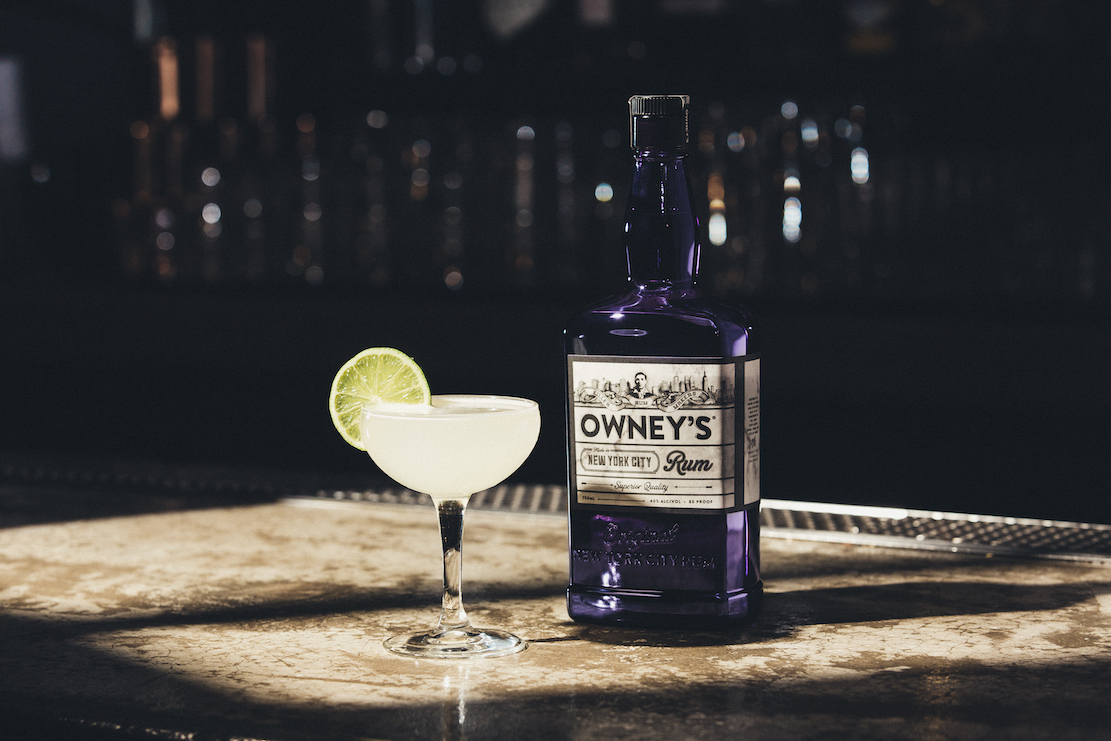
“I was born in Brooklyn, and
I found the best location in the borough, so here
we are,” says Firtle. “So,
obviously, I wanted to own New York as our home
market and, of course, it’s one
of the great cocktail cities in the world.
Outside of the city, I want to
share the spirit of New York with larger audiences
and also introduce more
people to rum.”
At the moment the main
markets for Owney’s Rum outside of New York are
Texas, Massachusetts,
California, Illinois and Florida.
The
key, Firtle believes, is
in advancing rum’s excellence as a mixer in a
cocktail, especially one like the
daiquiri. “Owney is not just a sipping rum,” she
insists. “I’m on a mission to
free the daiquiri from the blender and change the
perception of what the drink
has become over the past 50 years or so, and I
firmly believe that the daiquiri
deserves to sit amongst the
classics—a martini, Manhattan or an
old-fashioned—and become a true signature drink of
quality for a bar.”
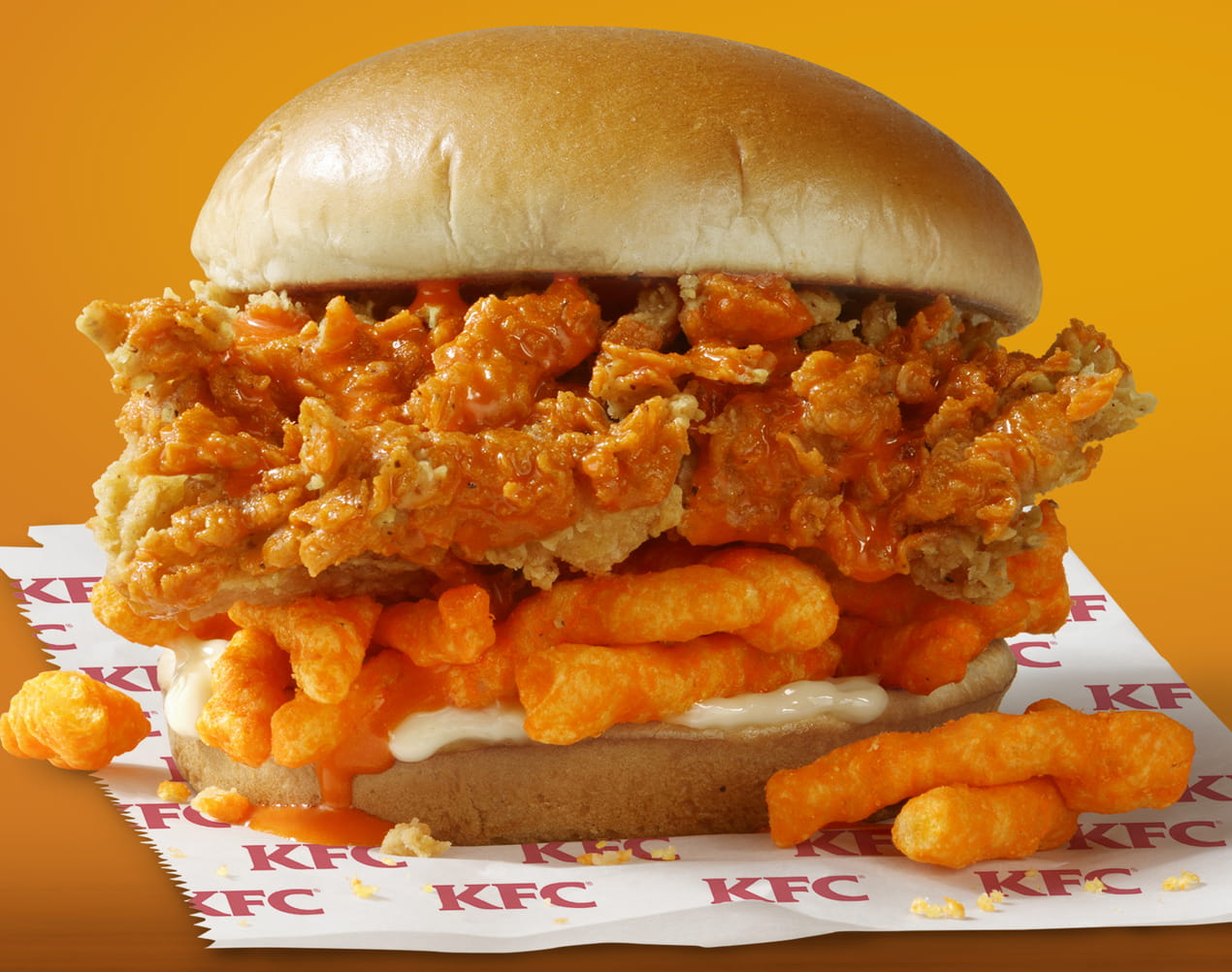
WHY NOT ADD MARSHMALLOW FLUFF?
KFC's newest item
is the Cheetos Sandwich, stacking Cheetos and fried
chicken into a bun, then pouring on "a custom
Cheetos sauce made by Frito-Lay."
FOOD WRITING 101: "Y" NOT?

❖❖❖
Wine
Column Sponsored by Banfi Vintners
SANGIOVESE
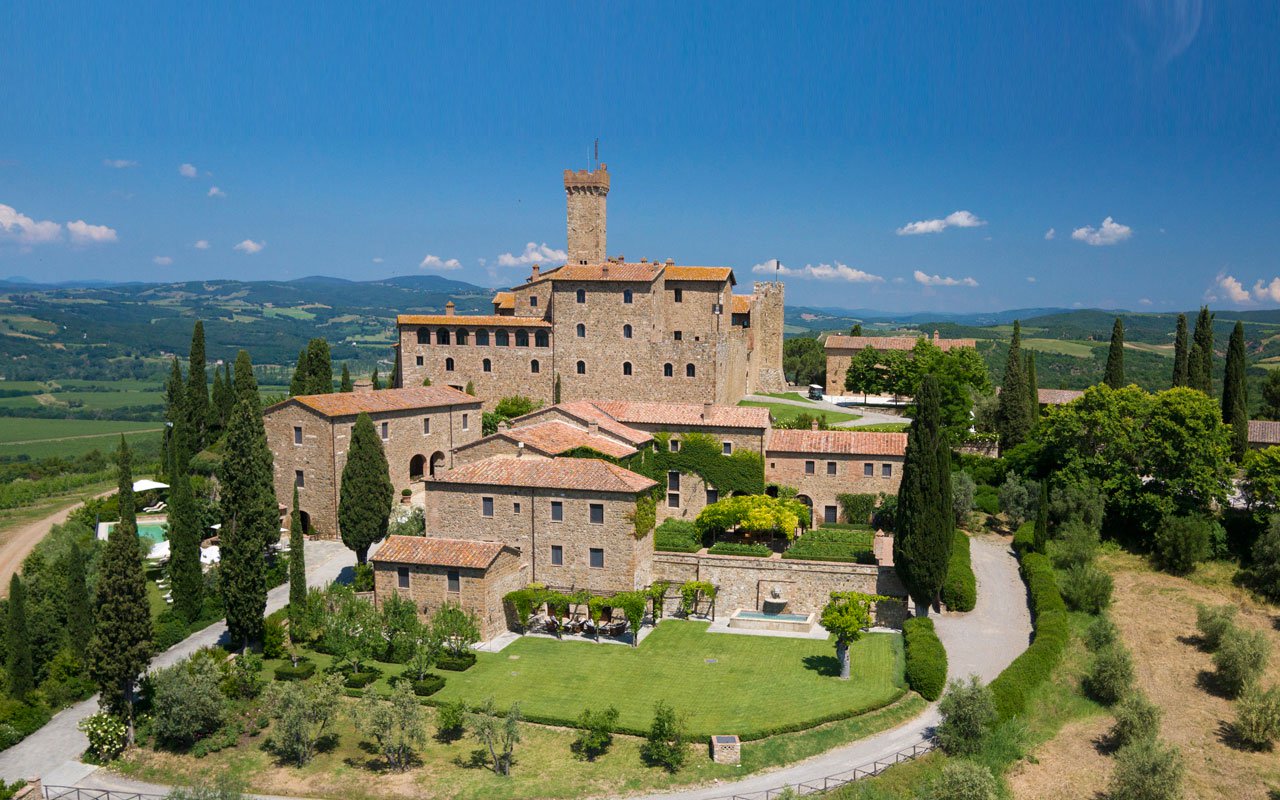 Wine is a joy year-round but
in cooler weather one
grape varietal has really taken center stage in
my daily activities – that most Italian of
grapes, Sangiovese, and its ultimate expression
– Brunello di Montalcino.
Wine is a joy year-round but
in cooler weather one
grape varietal has really taken center stage in
my daily activities – that most Italian of
grapes, Sangiovese, and its ultimate expression
– Brunello di Montalcino.
From mid-September through mid-October,
the Sangiovese grown for our various styles of red
wines are be harvested, culminating with the top
selection for Brunello di Montalcino.
Second, cooler weather here means
it is time to start enjoying more red wines and
especially Sangiovese based wines. That
includes Banfi’s cru of Brunello, Poggio alle Mura,
literally the cream of the crop of our Sangiovese
vineyards. Alongside our Poggio alle Mura Brunello di
Montalcino, this year we introduced two more wines
from the cru Poggio alle Mura – a Rosso di Montalcino
and a Riserva of Brunello. Rosso is sort of like the
younger brother of Brunello, also made from 100%
Sangiovese grapes but usually a selection from younger
vines and the wine is aged only two years compared to
the four required for Brunello. The
Riserva, on the other hand, is an even more selective
harvest of Sangiovese, and ages for an additional year
before release.
What is so special about this cru
Poggio alle Mura?
Well, it is the result our over 30 years of
ongoing research at my family’s vineyard estate,
Castello Banfi.
When we first began planting our vines there in
the late 1970s studies from the University of Bordeaux
indicated which strains of many varietals we should
plant, based on the soil type and microclimate of each
vineyard. But
when it came to the region’s native Sangiovese, there
was only local lore, no scientific research. So we took
it upon ourselves to figure out this vine, and set off
on three decades of incredibly detailed research.
We started
with 600 apparent variations on Sangiovese, because it
is so susceptible to variations in weather and soil,
and narrowed that down to 160 truly genetically
different clones.
We planted a vineyard with two rows of each
type, made wine from each of them, and charted the
differences – remember, you only get one chance a year
to make wine, so this took time.
It took about ten years to get some
concrete results, though we continue to experiment
today and always will – you never stop learning in
science and nature!
Once we determined which were the best,
complementary clones that could be planted together to
make the best Brunello, we chose to plant them in what
we determined to be the optimal vineyard sites. Coincidentally,
the best soils and climate conditions are in the
slopes surrounding the medieval fortress today known
as Castello Banfi, known since Etruscan times as
Poggio alle Mura – the walled hilltop. Hence the
name of our most special “cru” of Brunello,
representing a synthesis between tradition and
innovation.
Though the focus of this study was
our Brunello, all of our Sangiovese-based wines,
including the super Tuscans SummuS, Cum Laude, and
Centine, benefitted from this work. And that’s
the third reason for celebrating Sangiovese this
month, for the range of wonderful reds that usher us
into autumn! One
wine in particular was inspired by our research – the
BelnerO, a Sangiovese dominant blend with what I like
to call a kiss of Cabernet and a whisper of Merlot. We grow the
grapes a little differently for BelnerO than for
Brunello, make the wine with less oak aging and
released it earlier from the winery, providing a
counterpoint to Brunello and a lovely terroir-driven
wine in its own right.
If you
know Italians, you know that by nature we are
multi-faceted, varying in mood, and always passionate. As a
nation, we span from the hot sunny beaches of Sicily
near the African coast to the rugged mountains and
Alpine ski slopes of Trentino-Alto Adige in the north. Sangiovese
is grown in almost all of Italy’s regions and reflects
the unique nature of each; it is most famous
(rightfully so) in Tuscany, yet even there it reflects
the nuances of each hilltop, valley and subzone. It has
something a little different to say in Brunello than
Chianti, Morellino than Vino Nobile di Montepulciano,
Rosso di Montalcino than Super Tuscan blends.
Here is a smattering of
Sangiovese-based wines that you may wish to get to
know better, reflecting a spectrum that appeals to
every occasion, every taste, and every budget. We can
assure you that the conversation will never become
boring. 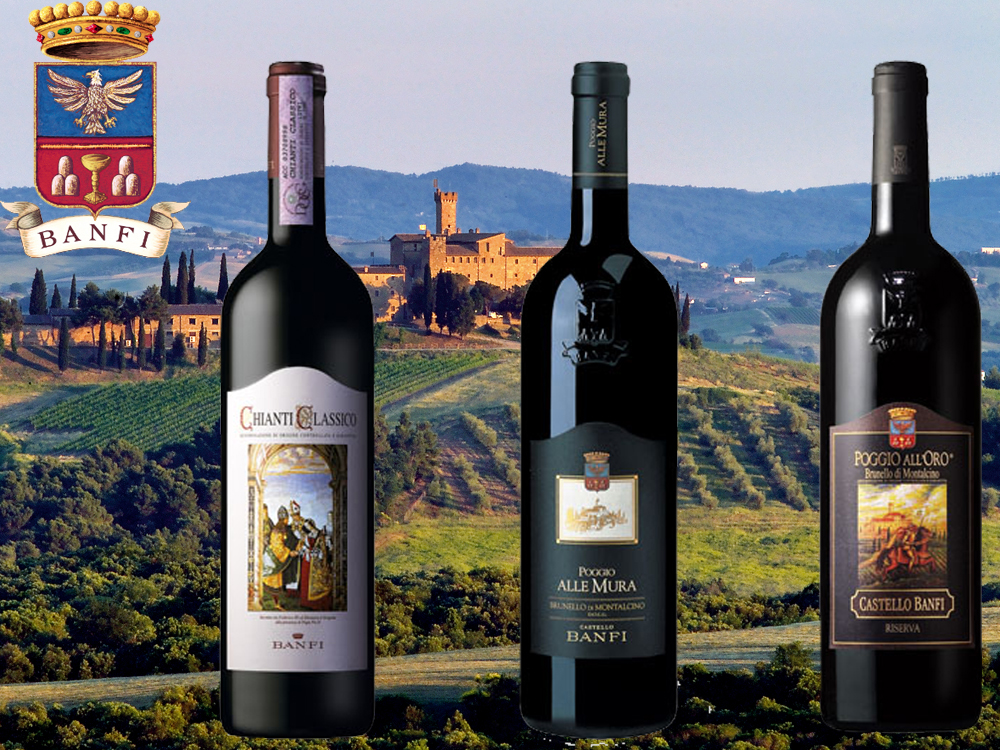
Recommendations for Celebrating
Sangiovese
BelnerO Proprietor’s Reserve Sangiovese
– A refined
cuvée of noble red grapes perfected by our pioneering
clonal research. This dark beauty, BelnerO, is
produced at our innovative winery, chosen 11
consecutive years as Italy’s Premier Vineyard Estate.
Fermented in our patented temperature controlled
French oak and aged approximately 2 additional years.
Unfiltered, and Nitrogen bottled to minimize sulfites.
Castello Banfi Brunello di Montalcino –
Rich, round, velvety and intensely
aromatic, with flavor hints of licorice, cherry, and
spices. Brunello di Montalcino possesses an intense
ruby-red color, and a depth, complexity and opulence
that is softened by an elegant, lingering aftertaste.
Unfiltered after 1998 vintage.
Castello Banfi Rosso di Montalcino – Brunello's "younger brother," produced
from select Sangiovese grapes and aged in barrique for
10 to 12 months. Deep ruby-red, elegant, vibrant,
well-balanced and stylish with a dry velvety
finish.
Poggio all’Oro Brunello di Montalcino
Riserva – A single vineyard selection of our most
historically outstanding Sangiovese, aged five years
before release, the additional year more than that
required of Brunello including 6 months in barrel and
6 months more in bottle to grant its “Riserva”
designation. Incredible
elegance and harmony. Intense with lots of fruit and
subtle wood influence. Round, complete, well balanced
with hints of chocolate and berries. Unfiltered after
1998.
Poggio alle Mura – The first tangible result of years of
intensive clonal research on Montalcino’s native
Sangiovese grape.
Estate bottled from the splendidly sun drenched
vineyards surrounding the medieval Castello from which
it takes its name.
The Brunello
di Montalcino is seductive, silky and smoky. Deep ruby
in color with an expressive bouquet of violets, fruits
and berries as well as cigar box, cedar and exotic
spices. The Rosso
di Montalcino is also intense ruby red. The bouquet
is fresh and fruity with typical varietal notes of
cherry and blackberry, enriched by more complex hints
of licorice, tobacco and hazelnut. It is full
bodied, yet with a soft structure, and a surprisingly
long finish. The Poggio alle Mura Brunello di Montalcino
Riserva is deep ruby red with garnet
reflections and a rich, ample bouquet that hints of
prune jam, coffee, cacao and a light balsamic note. It is full
and powerful, with ripe and gentle tannins that make
it velvety and harmonious; this wine is supported by a
pleasing minerality that to me speaks soundly of that
special hillside in southern Montalcino.
SummuS – A wine of towering elegance, SummuS is an
extraordinary blend of Sangiovese which contributes
body; Cabernet Sauvignon for fruit and structure; and
Syrah for elegance, character and a fruity bouquet. An elegant,
complex and harmonious red wine.
Cum Laude – A complex and elegant red which graduated
“With Honors,” characterized by aromas of juicy
berries and fresh spices.
Centine – A Cuvee that is more than half
Sangiovese, the balanced consisting of equal parts of
Cabernet Sauvignon and Merlot. Vinified in
a firm, round style that easily accompanies a wide
range of dishes, this is a smooth and fragrantly
satisfying wine with international character, and a
perennial favorite at my own dinner table.
Banfi Chianti Superiore – The “Superiore” designation signifies
stricter government regulations regarding production
and aging requirements, as compared to regular
Chianti. An
intense ruby red wine with fruit forward aromas and
floral notes. This
is a round wine with well-balanced acidity and fruit.
Banfi Chianti Classico – An enduring classic: alluring
bouquet of black fruit and violets; rich flavors of
cherry and leather; supple tannins and good acidity
for dining.
Banfi Chianti Classico Riserva – Produced from select grapes grown in the
"Classico" region of Chianti, this dry, fruity and
well-balanced red has a full bouquet reminiscent of
violets.
Fonte alla Selva Chianti Classico – This is our newest entry into the Chianti
arena, coming from a 99 acre estate in Castellina, the
heart of the Chianti Classico region. The wine is
a captivating mauve red that smells of cherry, plum
and blackberry with hints of spice. It is
round, full and balanced with very good
acidity.
Col di Sasso – Sangiovese and Cabernet Sauvignon. Luscious,
complex and soft with persistent notes of fruit and
great Italian style structure.
Any of John Mariani's books below may be ordered from amazon.com.
 The Hound in Heaven
(21st Century Lion Books) is a novella, and
for anyone who loves dogs, Christmas, romance,
inspiration, even the supernatural, I hope you'll find
this to be a treasured favorite. The story
concerns how, after a New England teacher, his wife and
their two daughters adopt a stray puppy found in their
barn in northern Maine, their lives seem full of promise.
But when tragedy strikes, their wonderful dog Lazarus and
the spirit of Christmas are the only things that may bring
his master back from the edge of despair.
The Hound in Heaven
(21st Century Lion Books) is a novella, and
for anyone who loves dogs, Christmas, romance,
inspiration, even the supernatural, I hope you'll find
this to be a treasured favorite. The story
concerns how, after a New England teacher, his wife and
their two daughters adopt a stray puppy found in their
barn in northern Maine, their lives seem full of promise.
But when tragedy strikes, their wonderful dog Lazarus and
the spirit of Christmas are the only things that may bring
his master back from the edge of despair. WATCH THE VIDEO!
“What a huge surprise turn this story took! I was completely stunned! I truly enjoyed this book and its message.” – Actress Ali MacGraw
“He had me at Page One. The amount of heart, human insight, soul searching, and deft literary strength that John Mariani pours into this airtight novella is vertigo-inducing. Perhaps ‘wow’ would be the best comment.” – James Dalessandro, author of Bohemian Heart and 1906.
“John Mariani’s Hound in Heaven starts with a well-painted portrayal of an American family, along with the requisite dog. A surprise event flips the action of the novel and captures us for a voyage leading to a hopeful and heart-warming message. A page turning, one sitting read, it’s the perfect antidote for the winter and promotion of holiday celebration.” – Ann Pearlman, author of The Christmas Cookie Club and A Gift for my Sister.
“John Mariani’s concise, achingly beautiful novella pulls a literary rabbit out of a hat – a mash-up of the cosmic and the intimate, the tragic and the heart-warming – a Christmas tale for all ages, and all faiths. Read it to your children, read it to yourself… but read it. Early and often. Highly recommended.” – Jay Bonansinga, New York Times bestselling author of Pinkerton’s War, The Sinking of The Eastland, and The Walking Dead: The Road To Woodbury.
“Amazing things happen when you open your heart to an animal. The Hound in Heaven delivers a powerful story of healing that is forged in the spiritual relationship between a man and his best friend. The book brings a message of hope that can enrich our images of family, love, and loss.” – Dr. Barbara Royal, author of The Royal Treatment.
 |
The Encyclopedia of American Food and Drink by John F. Mariani (Bloomsbury USA, $35) Modesty forbids me to praise my own new book, but let me proudly say that it is an extensive revision of the 4th edition that appeared more than a decade ago, before locavores, molecular cuisine, modernist cuisine, the Food Network and so much more, now included. Word origins have been completely updated, as have per capita consumption and production stats. Most important, for the first time since publication in the 1980s, the book includes more than 100 biographies of Americans who have changed the way we cook, eat and drink -- from Fannie Farmer and Julia Child to Robert Mondavi and Thomas Keller. "This book is amazing! It has entries for everything from `abalone' to `zwieback,' plus more than 500 recipes for classic American dishes and drinks."--Devra First, The Boston Globe. "Much needed in any kitchen library."--Bon Appetit. |
"Eating Italian will never be the same after reading John Mariani's entertaining and savory gastronomical history of the cuisine of Italy and how it won over appetites worldwide. . . . This book is such a tasteful narrative that it will literally make you hungry for Italian food and arouse your appetite for gastronomical history."--Don Oldenburg, USA Today. "Italian
restaurants--some good, some glitzy--far
outnumber their French rivals. Many of
these establishments are zestfully described
in How Italian Food Conquered the World, an
entertaining and fact-filled chronicle by
food-and-wine correspondent John F.
Mariani."--Aram Bakshian Jr., Wall Street
Journal.
"Equal parts
history, sociology, gastronomy, and just
plain fun, How Italian Food Conquered the
World tells the captivating and delicious
story of the (let's face it) everybody's
favorite cuisine with clarity, verve and
more than one surprise."--Colman Andrews,
editorial director of The Daily
Meal.com. "A fantastic and fascinating
read, covering everything from the influence
of Venice's spice trade to the impact of
Italian immigrants in America and the
evolution of alta cucina. This book will
serve as a terrific resource to anyone
interested in the real story of Italian
food."--Mary Ann Esposito, host of PBS-TV's
Ciao
Italia. "John Mariani has written the
definitive history of how Italians won their
way into our hearts, minds, and
stomachs. It's a story of pleasure over
pomp and taste over technique."--Danny Meyer,
owner of NYC restaurants Union Square
Cafe, The Modern, and Maialino.
|
 |
 |
 |
 |
 |
 |
 |
 |
 Everett Potter's Travel Report:
Everett Potter's Travel Report: 
 Eating Las Vegas
JOHN CURTAS has been covering the Las Vegas
food and restaurant scene since 1995. He is
the co-author of EATING LAS VEGAS – The 50
Essential Restaurants (as well as
the author of the Eating Las Vegas web site: www.eatinglasvegas.
He can also be seen every Friday morning as
the “resident foodie” for Wake Up With the
Wagners on KSNV TV (NBC) Channel 3 in
Las Vegas.
Eating Las Vegas
JOHN CURTAS has been covering the Las Vegas
food and restaurant scene since 1995. He is
the co-author of EATING LAS VEGAS – The 50
Essential Restaurants (as well as
the author of the Eating Las Vegas web site: www.eatinglasvegas.
He can also be seen every Friday morning as
the “resident foodie” for Wake Up With the
Wagners on KSNV TV (NBC) Channel 3 in
Las Vegas.
MARIANI'S VIRTUAL GOURMET
NEWSLETTER is published weekly. Publisher: John Mariani. Editor: Walter Bagley. Contributing Writers: Christopher Mariani,
Robert Mariani, Misha Mariani, John A. Curtas, Gerry Dawes, Geoff Kalish,
and Brian Freedman. Contributing
Photographer: Galina Dargery. Technical
Advisor: Gerry
McLoughlin.
If you wish to subscribe to this
newsletter, please click here: http://www.johnmariani.com/subscribe/index.html
© copyright John Mariani 2019

